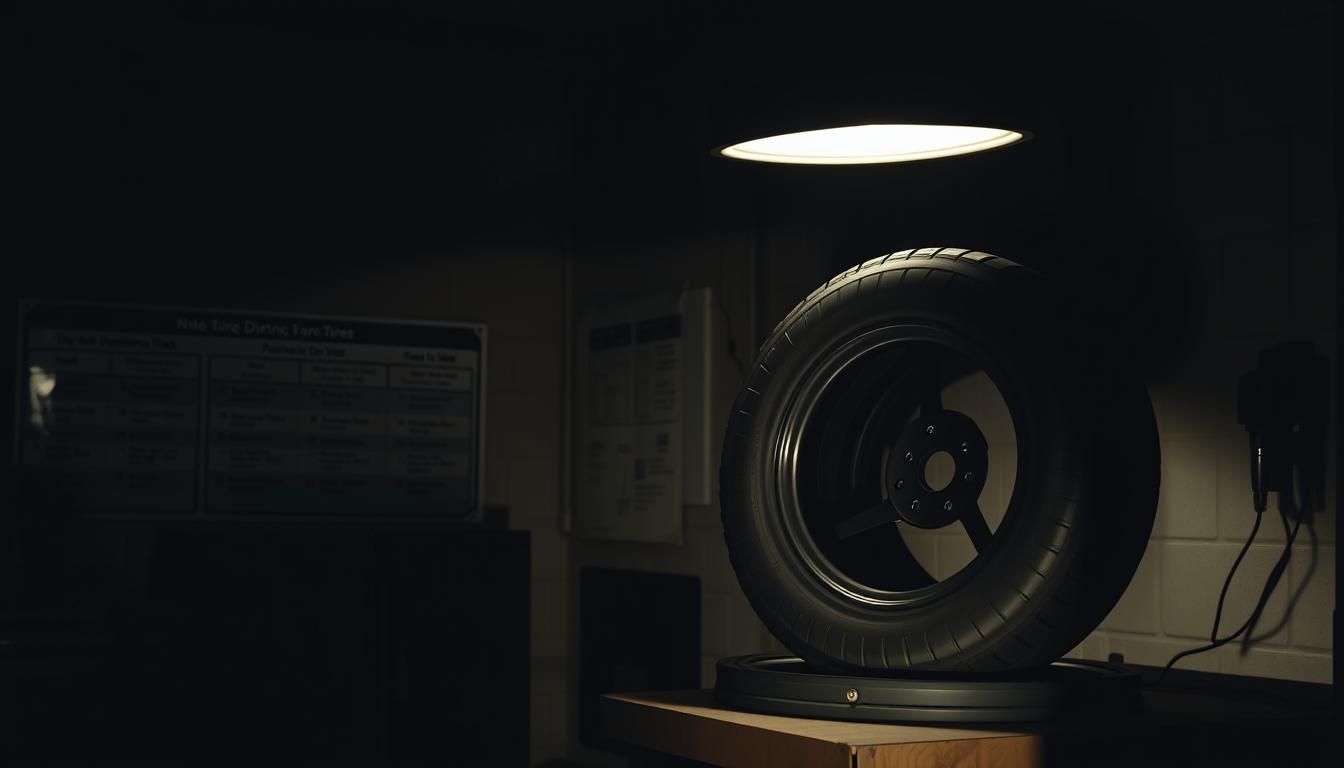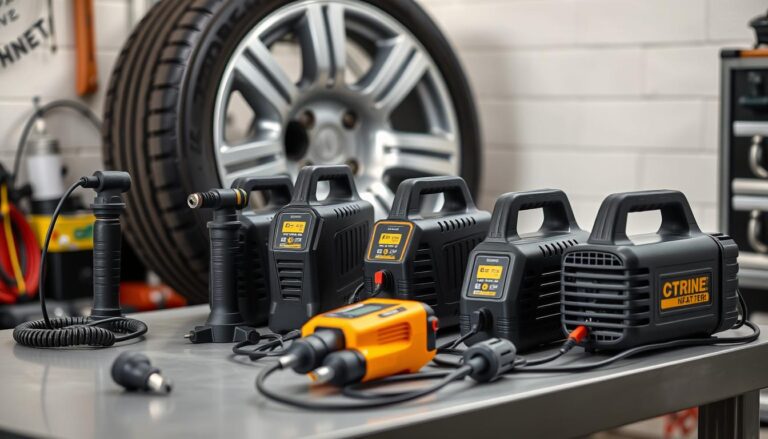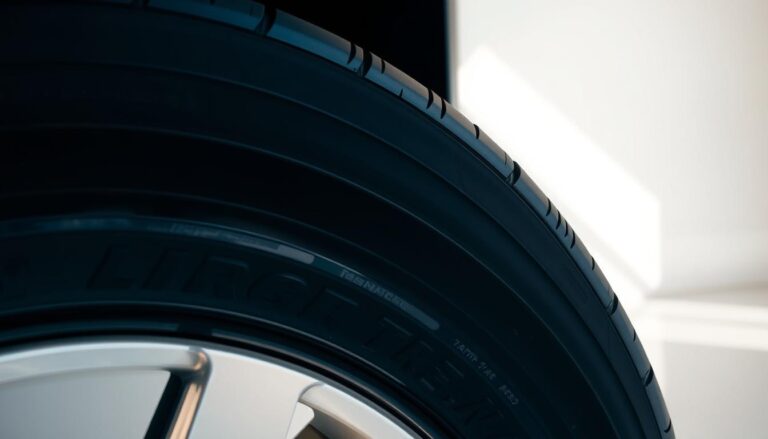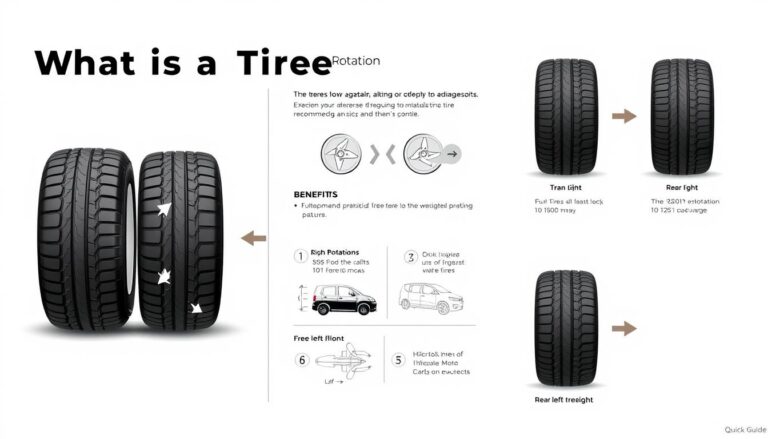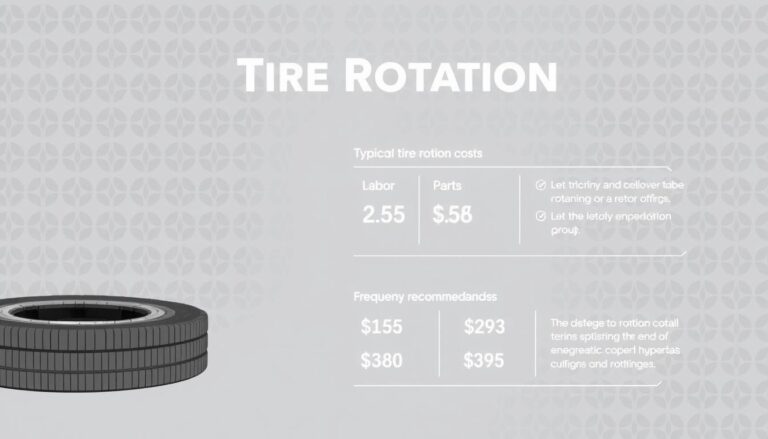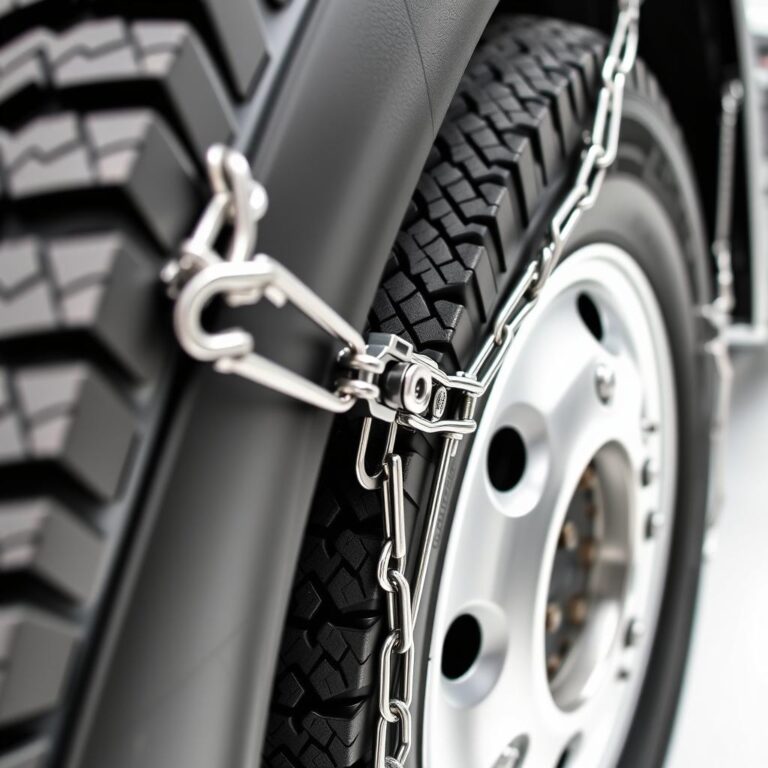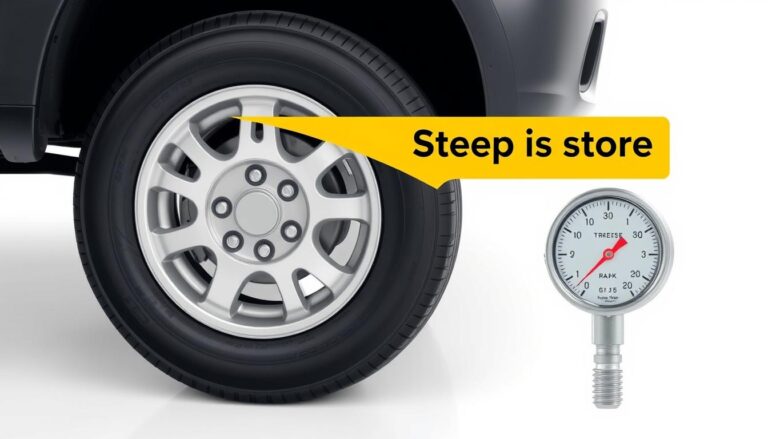Driving on a Spare Tire: How Far Can You Go?
When your tire gets a flat, knowing how far you can drive on a spare is key. Many drivers are unsure about the limits of spare tire use. This uncertainty can lead to safety risks and damage to your car.
Spare tires aren’t made for long trips. The distance you can drive on a spare depends on several things. These include the type of spare tire, your car’s specs, and the road conditions. Most spares have strict rules about how far and how fast you can go.
Most cars have two types of spare tires: full-size spares and compact ones. Each has its own rules for how far you can drive. Knowing these limits helps avoid getting stuck on the side of the road and keeps your car running well.
Understanding how to use your spare tire can prevent big problems. This guide will give you the info you need to handle tire emergencies safely and efficiently.
Understanding Spare Tire Basics and Types
Spare tires are key safety items in today’s cars. They help drivers when a tire fails unexpectedly. Knowing the different types of spare tires is important. Each has its own performance and how far it can go.
Car makers usually give drivers two main types of spare tires. Each has its own set of rules and limits on how it can be used:
Full-Size Spare Tires vs. Temporary Donut Spares
- Full-Size Spare Tires
- They match the size of your car’s tires
- They let you drive without worry
- You can rotate them with your regular tires
- Temporary Donut Spares
- They are small and light
- Good for short trips (about 50-70 miles)
- Best for emergencies only
Space-Saver Tire Specifications
Space-saver spares are made for emergencies and to save space. They usually have:
| Specification | Typical Characteristics |
|---|---|
| Width | They are thinner than regular tires |
| Recommended Speed | Don’t go over 50 mph |
| Recommended Distance | Good for up to 50-70 miles |
Compact Spare Tire Construction
Compact spare tires use light materials. This helps keep the car light and easy to move. They are made for quick fixes, not for long trips.
Knowing about these spare tires helps drivers make smart choices in emergencies. It makes driving safer and more confident.
How Far Can You Drive on a Spare Tire: Safety Guidelines

Driving on a spare tire needs careful attention to distance and safety. The distance you can drive on a spare tire depends on the type. Most temporary spares are for emergency use only.
For space-saver or donut spare tires, here are some guidelines:
- Maximum recommended distance: 50-70 miles
- Ideal speed limit: 50 miles per hour or less
- Avoid long-distance travel
The distance you can drive on a spare tire depends on several things:
- Tire type (donut vs. full-size spare)
- Vehicle weight
- Road conditions
- Driving environment
Full-size spare tires can handle longer trips and tougher driving. It’s best to get a permanent tire as soon as you can after using a spare.
Important safety tips for using a spare tire include:
- Check tire pressure before driving
- Avoid highway driving
- Minimize sudden movements
- Plan the shortest route to tire replacement
Remember, spare tires are for emergencies. They’re not for long trips or high speeds. Your main goal is to get to a tire repair shop safely and fast.
Speed Limitations When Using a Temporary Spare
Driving with a spare tire needs careful attention to speed and road conditions. Knowing the spare tire’s driving capacity is key to safety and avoiding damage in emergencies.

Temporary spare tires are made for short-term use with certain limits. Drivers must understand these limits to ensure safe travel and protect their vehicle.
Maximum Speed Recommendations
Most temporary spare tires have strict speed limits to avoid failures. Here are some guidelines:
- Maximum recommended speed: 50 miles per hour
- Maximum spare tire duration of use: 50-70 miles
- Recommended driving time: Less than 1 week
Impact of Higher Speeds on Spare Tire Wear
Going over the recommended speed can greatly increase tire wear and safety risks. Temporary spares are less stable at high speeds.
| Speed Range | Potential Risks | Recommended Action |
|---|---|---|
| Under 50 mph | Minimal Risk | Safe Driving Conditions |
| 50-60 mph | Moderate Wear | Reduce Speed Immediately |
| Over 60 mph | High Failure Risk | Stop and Replace Tire |
Weather Conditions Considerations
Bad weather can make spare tires perform worse. Rain, snow, and rough roads mean you should drive slower and be extra careful.
- Reduce speed in wet conditions
- Avoid sudden turns or braking
- Maintain increased following distance
Spare Tire Pressure Requirements and Maintenance

Keeping the right tire pressure is key when using a spare tire. The life of your spare tire depends on its inflation and condition. Many drivers don’t realize how important it is to check the spare tire pressure regularly.
Spare tires need different pressure levels than regular tires. Compact spare tires often need higher pressure to support vehicle weight. It’s best to check the spare tire pressure every three months or during routine car maintenance.
- Check spare tire pressure using a reliable tire gauge
- Inflate to the manufacturer’s recommended PSI
- Inspect for visible damage or wear
- Rotate and replace as needed
When figuring out how far you can drive on a spare tire, pressure is very important. Underinflated spare tires can be unsafe and cut down on driving distance. Always follow the exact pressure recommended in your car’s manual for the best performance.
Regular care helps extend the life of your spare tire and avoids unexpected breakdowns. Always carry a portable air compressor in your car for quick pressure checks during long drives.
| Spare Tire Type | Recommended PSI | Check Frequency |
|---|---|---|
| Compact Spare | 60 PSI | Every 3 months |
| Full-Size Spare | 35-42 PSI | During oil changes |
By sticking to these tips, you can make your spare tire safer and more reliable. This way, you’ll be ready for any unexpected road situations.
Signs of Spare Tire Wear and When to Replace
Keeping your spare tire in good shape is key for safe driving. Regular checks can stop unexpected failures. This is important when you need your spare tire most.
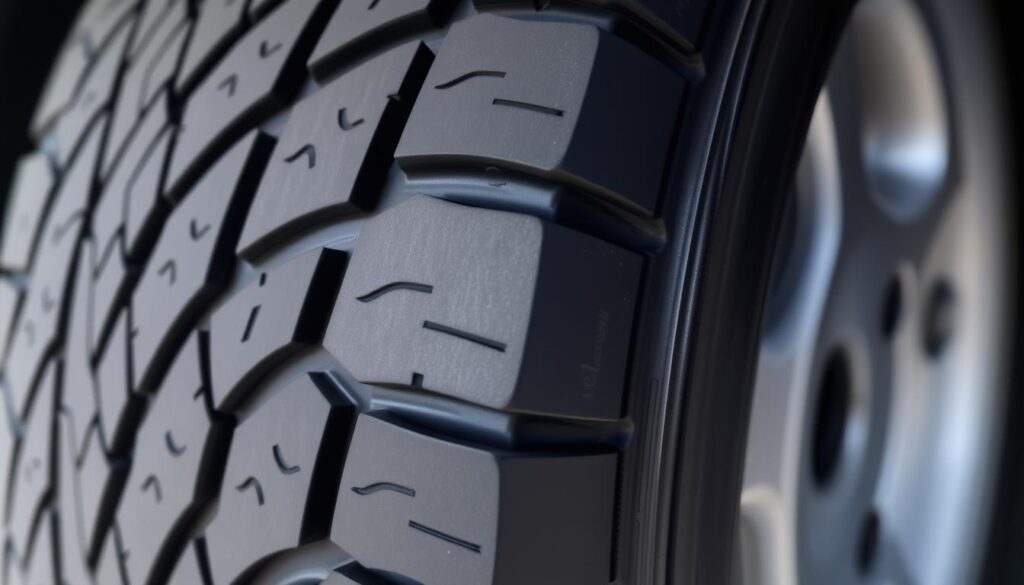
Inspecting your spare tire involves several steps. This ensures it stays reliable for emergencies.
Visual Inspection Guidelines
A detailed look can spot problems early. Watch for these signs:
- Visible cracks in the sidewall
- Unusual bulges or deformations
- Uneven or excessive tread wear
- Signs of dry rot or aging
Warning Signs of Damage
Some signs mean your spare tire is not safe:
- Deep cuts or punctures that compromise structural integrity
- Significant rubber deterioration
- Exposed inner layers or fabric
- Persistent air pressure loss
Age-Related Deterioration
Spare tires get worse over time, even if not used. Experts say to replace them every six to ten years. This is because rubber breaks down from heat, humidity, and sun.
If you’re unsure about your spare tire, get a mechanic’s opinion. They can check its safety and how much longer it will last.
Emergency Situations and Spare Tire Usage
Unexpected tire failures can surprise drivers, making it key to know how to use a spare tire. When a tire fails, knowing how to handle the spare can prevent a big problem. It’s all about the right distance and handling.
Drivers need to be ready for unexpected situations with a spare tire. The safe distance to drive on a spare tire is usually 50-70 miles. This depends on the spare tire type and your vehicle’s condition.
- Assess the damage to your primary tire
- Check the spare tire’s condition before installation
- Locate the nearest tire repair shop
- Drive cautiously and maintain reduced speeds
Here are some key steps in an emergency:
- Pull over safely to a flat, stable surface
- Use hazard lights to alert other drivers
- Ensure you have necessary safety equipment
- Replace the damaged tire quickly
| Spare Tire Type | Maximum Travel Distance | Recommended Speed |
|---|---|---|
| Full-Size Spare | Unlimited | Normal driving speeds |
| Compact Temporary Spare | 50-70 miles | 50 mph maximum |
Remember, spare tires are only for temporary use. Get your primary tire fixed or replaced as soon as you can. This keeps your vehicle safe and running well.
Impact of Vehicle Weight and Load on Spare Tire Performance
Driving on a spare tire requires knowing how vehicle weight affects it. The spare tire’s performance depends on several factors, like the vehicle’s load and how weight is spread out.
Managing weight properly is key to using a spare tire safely. Drivers need to think about a few important things to ensure they’re driving safely:
- Distribute weight evenly across the vehicle
- Reduce unnecessary cargo when using a spare tire
- Avoid overloading the vehicle
Weight Distribution Guidelines
It’s vital to keep weight balanced when driving on a spare tire. Uneven weight can put too much stress on the spare tire, which might cause it to fail early or make driving unsafe.
- Remove non-essential items from the vehicle
- Ensure passengers are seated strategically
- Check tire pressure before driving
Cargo Considerations While Using a Spare
It’s important to keep the vehicle’s load down when using a spare tire. Experts say to cut the vehicle’s weight by at least 20% to avoid too much stress on the temporary tire.
Here are some ways to reduce weight:
- Removing heavy equipment
- Emptying trunk contents
- Avoiding towing or hauling
By managing vehicle weight and knowing the limits of spare tires, drivers can safely get through emergencies. This helps avoid risks that come with using a temporary tire.
Best Practices for Extended Spare Tire Use
When you get a flat tire, knowing how far you can drive on a spare is key. The rule for spare tire use varies. Drivers need to be careful and plan ahead.
Here are some key tips for using a spare tire for a long time:
- Limit driving distance to 50-70 miles maximum
- Maintain speeds under 50 miles per hour
- Inspect spare tire pressure before each use
- Minimize heavy cargo loads during spare tire operation
Keeping your spare tire in good shape is important. Regular checks can spot problems early.
| Inspection Focus | Recommended Action |
|---|---|
| Tire Pressure | Check weekly, maintain recommended PSI |
| Tread Condition | Look for cracks, bulges, or uneven wear |
| Storage Location | Keep in cool, dry environment |
Safety should always be your primary concern when using a spare tire. Try to get a new tire as soon as you can. This keeps your car running well and safe on the road.
Remember, spare tires are for emergencies only. Knowing how far you can drive on one is helpful. But, the goal is to get back to a regular tire as fast as you can.
Conclusion
Knowing how far you can drive on a spare tire is key for safety. Most spare tires are meant for short distances, like 50-70 miles. Each car and spare tire has its own limits, so it’s important to pay attention and manage them well.
Keeping your spare tire in good shape can help avoid big problems. Check its air pressure, tread, and structure often. This way, you’re ready for emergencies without risking your car’s safety or performance.
Your car’s manual is the best source for using your spare tire. Experts say to use spares only until you can get a real tire fixed or replaced. Drive carefully, check your tire pressure, and know what your spare can handle. This way, you can face unexpected road issues with confidence.
Knowing the limits of your spare tire can turn a stressful situation into a manageable one. Regular car care, being ready, and getting help fast are all important. They help keep you safe on the road, even when you face unexpected tire problems.
